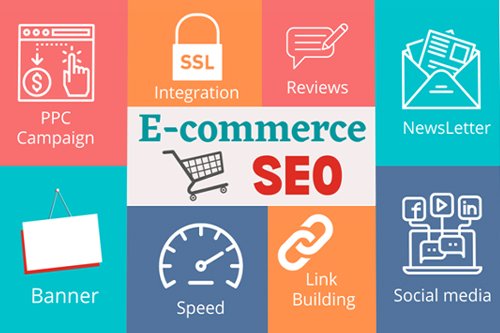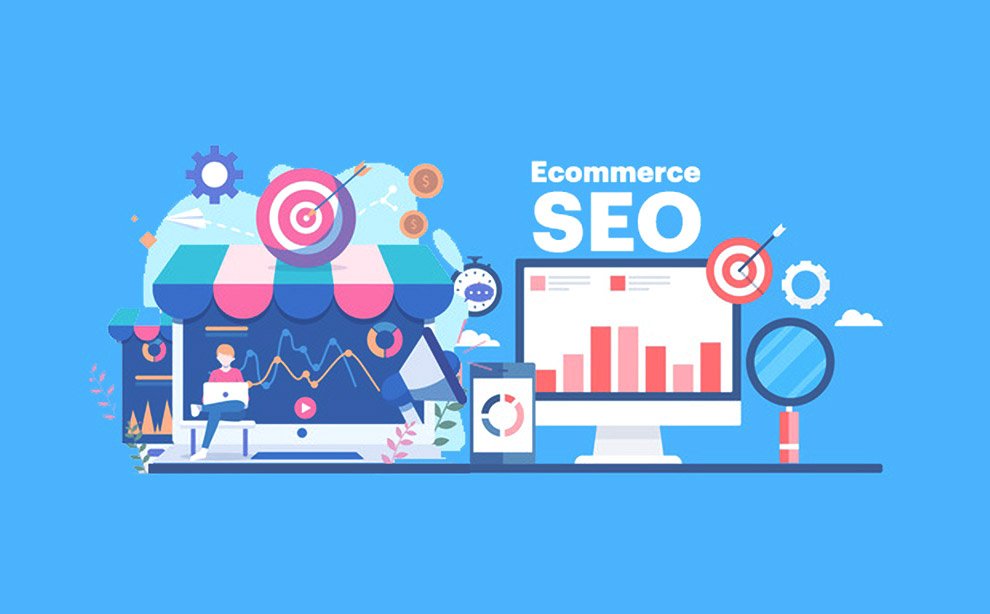From Keywords to Conversion: A Step-by-Step Guide to E-commerce SEO
February 25, 2024 | by seotoolsethub.com

E-commerce SEO, or search engine optimization, is the practice of optimizing online stores to improve their visibility and rankings on search engine results pages (SERPs). It involves various strategies and techniques aimed at increasing organic traffic and attracting potential customers. In today’s digital age, where online shopping has become increasingly popular, having a strong presence in search engines is crucial for the success of any e-commerce business.
The importance of E-commerce SEO cannot be overstated. With millions of websites competing for attention on the internet, online businesses need to optimize their websites to stand out from the crowd. By implementing effective SEO strategies, e-commerce websites can increase their visibility in search engines like Google, Bing, and Yahoo. This increased visibility leads to higher organic traffic and ultimately more sales.
Key Takeaways
- Keywords are crucial for successful e-commerce SEO
- Conduct thorough keyword research to identify the most relevant and profitable keywords for your e-commerce website
- Optimize on-page elements such as title tags, meta descriptions, and product descriptions to improve search engine visibility
- Off-page optimization techniques such as link building and social media marketing can also boost e-commerce SEO performance
- Focus on creating high-quality content and optimizing product pages to improve user experience and drive conversions.
Understanding the Importance of Keywords in E-commerce SEO
Keywords play a vital role in E-commerce SEO as they directly impact search engine rankings. When users perform searches on search engines using specific keywords or phrases related to products or services offered by an e-commerce website, those keywords must be strategically incorporated into the website’s content.
Different types of keywords are relevant for e-commerce websites:
1) Broad Keywords: These are general terms that describe a broad category or industry related to an e-commerce website’s products or services.
2) Long-Tail Keywords: These are more specific keyword phrases that target niche markets within a broader industry.
3) Branded Keywords: These include specific brand names associated with products sold by an e-commerce website.
To identify relevant keywords for an e-commerce website, there are several keyword research tools available such as Google Keyword Planner, SEMrush Keyword Magic Tool, and Moz Keyword Explorer. These tools provide valuable insights into keyword competition levels and search volume data which can help inform keyword selection decisions.
Conducting Keyword Research for E-Commerce Websites
Conducting thorough keyword research is a crucial step in E-commerce SEO. It involves identifying the most relevant and high-performing keywords that will drive targeted traffic to an e-commerce website. Here are the steps involved in conducting effective keyword research:
1) Identify Target Audience: Understanding the target audience is essential for selecting appropriate keywords. Consider factors such as demographics, interests, and search behavior.
2) Brainstorm Relevant Keywords: Start by brainstorming a list of potential keywords related to the products or services offered by the e-commerce website. Include both broad and long-tail keywords.
3) Use Keyword Research Tools: Utilize the keyword research tools mentioned earlier to expand your list of potential keywords. These tools provide valuable data on search volume, competition levels, and related keyword suggestions.
4) Analyze Keyword Competition and Search Volume: Evaluate the competition levels for each keyword using metrics like difficulty score or competition level provided by keyword research tools. Also, consider search volume data to prioritize high-volume keywords with manageable competition.
5) Identify Long-Tail Keywords: Long-tail keywords are often less competitive but highly targeted. Look for specific phrases that align with user intent and have lower competition levels.
By following these steps, e-commerce websites can identify relevant keywords that will help them rank higher in search engine results pages (SERPs), attract targeted traffic, and increase conversions.
On-page Optimization Techniques for E-Commerce Websites
| Keyword research | Identifying relevant keywords for the website’s content and products | Improved search engine rankings and targeted traffic |
| Meta tags optimization | Optimizing meta titles and descriptions for each page | Increased click-through rates and better search engine visibility |
| Content optimization | Better user engagement, improved search engine rankings, and increased conversions | Better user engagement, improved search engine rankings and increased conversions |
| Image optimization | Optimizing images for faster loading times and better search engine visibility | Improved user experience and search engine rankings |
| Internal linking | Linking relevant pages within the website to improve navigation and user experience | Better user engagement and improved search engine rankings |
| Better user experience, improved search engine rankings, and increased conversions | Optimizing the website for mobile devices | Better user experience and improved search engine rankings |
| Page speed optimization | Optimizing the website’s loading speed | Better user experience, improved search engine rankings and increased conversions |
On-page optimization refers to optimizing various elements within an e-commerce website’s pages to improve its visibility on search engines. It involves optimizing title tags, meta descriptions, header tags (H1-H6), product descriptions, images, URLs, internal linking structures, and more.
Title tags are one of the most important on-page elements as they provide a concise description of what a webpage is about. Including relevant keywords in title tags can significantly impact search engine rankings for specific queries related to those keywords.
Meta descriptions are summaries that appear below the title tags in search engine results. They provide an opportunity to entice users to click on a webpage by providing a compelling description of its content. Including relevant keywords and a clear call-to-action in meta descriptions can improve click-through rates.
Header tags (H1-H6) are used to structure the content on web pages. The H1 tag is typically reserved for the main heading of a page, while the H2-H6 tags are used for subheadings and other hierarchical elements. Including relevant keywords in header tags can help search engines understand the context and relevance of the content.
Optimizing product descriptions is crucial for e-commerce websites as it helps both search engines and potential customers understand what products are being offered. Including relevant keywords naturally within product descriptions can improve search engine rankings and attract targeted traffic.
Images also play an important role in e-commerce SEO. Optimizing images by including descriptive alt text, compressing file sizes, and using appropriate file names can improve website performance, user experience, and visibility on image search results.
By implementing these on-page optimization techniques, e-commerce websites can enhance their visibility on search engines, attract targeted traffic, and increase conversions.

Off-page Optimization Techniques for E-Commerce Websites
Off-page optimization refers to activities conducted outside of an e-commerce website that influence its visibility on search engines. It involves building high-quality backlinks from authoritative websites, leveraging social media platforms effectively, and engaging with online communities related to the industry or niche market.
Building high-quality backlinks is one of the most effective off-page optimization techniques for improving organic rankings. Backlinks act as votes of confidence from other websites indicating that your website has valuable content worth linking to. However, it’s important to focus on quality rather than quantity when building backlinks as low-quality or spammy links can have negative consequences.
To build high-quality backlinks for e-commerce websites:
1) Create valuable content that others will naturally want to link to.
2) Reach out to relevant industry influencers or bloggers and ask them to review or feature your products on their websites.
3) Guest post on authoritative websites within your industry, including a link back to your e-commerce website in the author bio or within the content itself.
Leveraging social media platforms is another important off-page optimization technique for e-commerce SEO. By actively engaging with potential customers through social media channels, e-commerce websites can increase brand visibility, drive traffic, and generate leads. It’s important to create compelling and shareable content that encourages users to engage with and share it across their networks.
Additionally, participating in online communities related to the industry or niche market can help build brand awareness and establish credibility. Engaging in discussions, answering questions, and providing valuable insights can position an e-commerce website as an authority within its field.
By implementing these off-page optimization techniques, e-commerce websites can improve their visibility on search engines, attract targeted traffic from authoritative sources, and increase conversions.
Creating High-Quality Content for E-Commerce Websites
High-quality content is essential for successful E-commerce SEO. It not only helps improve search engine rankings but also engages potential customers by providing valuable information about products or services offered by an e-commerce website.
Various types of content are relevant for e-commerce websites:
1) Product Descriptions: Well-written product descriptions that highlight key features and benefits of products can help search engines understand what the product is about and potential customers make informed purchasing decisions.
2) Blog Posts: Publishing informative blog posts related to the industry or niche market can help establish an e-commerce website as a trusted source of information. Blog posts should be optimized with relevant keywords while providing valuable insights or solving common problems faced by potential customers.
3) How-to Guides/Tutorials: Creating how-to guides or tutorials related to products sold by an e-commerce website can attract targeted traffic and position the website as an authority within its field. These guides should be optimized with relevant keywords and provide step-by-step instructions or tips.
4) Videos: Creating videos showcasing products, providing demonstrations, or offering tutorials can engage potential customers and increase conversions. Videos should be optimized with relevant keywords in titles, descriptions, and tags.
When creating high-quality content for e-commerce websites, it’s important to focus on providing value to potential customers rather than solely optimizing for search engines. By creating content that is informative, engaging, and shareable, e-commerce websites can improve their visibility on search engines while building brand loyalty.

Optimizing Product Pages for E-Commerce Websites
Product pages are the heart of any e-commerce website as they directly impact sales and conversions. Optimizing product pages is crucial for E-commerce SEO as it helps improve search engine rankings while providing a seamless user experience.
To optimize product pages effectively:
1) Optimize Product Titles: Include relevant keywords naturally within product titles to improve search engine rankings for specific queries related to those keywords. Keep titles concise but descriptive enough to entice potential customers.
2) Optimize Product Descriptions: Write unique and compelling product descriptions that highlight key features, benefits, and specifications of products. Include relevant keywords naturally within the descriptions without keyword stuffing.
3) Optimize Product Images: Use high-quality images that showcase products from different angles or in-use scenarios. Compress image file sizes without compromising quality to ensure fast loading times. Include descriptive alt text using relevant keywords in image tags.
4) Leverage Customer Reviews: Encourage customers to leave reviews on product pages as they not only provide valuable social proof but also help improve search engine rankings by adding fresh user-generated content regularly.
By optimizing product pages effectively with relevant keywords and engaging content elements such as images and customer reviews, e-commerce websites can enhance their visibility on search engines while improving user experience leading to increased conversions.
Implementing Technical SEO for E-Commerce Websites
Technical SEO refers to optimizing the technical aspects of a website to improve its visibility on search engines. It involves various techniques aimed at improving website speed, mobile responsiveness, user experience, and implementing structured data.
Website speed is a crucial factor in E-commerce SEO as it directly impacts user experience and search engine rankings. Slow-loading websites can lead to higher bounce rates and lower conversions. To optimize website speed:
1) Compress Images: Optimize image file sizes without compromising quality using tools like Adobe Photoshop or online image compressors.
2) Enable Browser Caching: Set up browser caching to store static files locally on users’ devices, reducing load times for returning visitors.
3) Minify CSS and JavaScript: Remove unnecessary characters from CSS and JavaScript files by minifying them, reducing file sizes and improving load times.
Mobile responsiveness is another important aspect of technical SEO as more users are accessing the internet through mobile devices. Websites that are not optimized for mobile devices may have lower search engine rankings. To optimize mobile responsiveness:
1) Use Responsive Design: Implement responsive design techniques that automatically adjust the layout of webpages based on screen size or device type.
2) Test Across Multiple Devices: Regularly test your e-commerce website across various devices such as smartphones, tablets, and desktops to ensure a consistent user experience.
Implementing structured data using schema markup can help search engines understand the content of an e-commerce website better. Structured data provides additional context about products or services offered by an e-commerce website which can lead to enhanced visibility in search results through rich snippets or other special features.
By implementing these technical SEO techniques effectively, e-commerce websites can improve their visibility on search engines while providing a seamless user experience leading to increased conversions.
Measuring and Analyzing E-Commerce SEO Performance
Measuring E-commerce SEO performance is essential for understanding the effectiveness of implemented strategies and identifying areas for improvement. By tracking website traffic, search engine rankings, and other key metrics, e-commerce websites can make data-driven decisions to optimize their SEO efforts.
There are several tools available for tracking website traffic and search engine rankings:
1) Google Analytics: A free web analytics tool provided by Google that provides valuable insights into website traffic, user behavior, conversions, and more.
2) Google Search Console: A free tool provided by Google that allows webmasters to monitor how their website is performing in search results. It provides data on impressions, clicks, average position in SERPs, crawl errors, and more.
3) SEMrush: A comprehensive SEO tool that offers features like keyword research, competitor analysis, backlink analysis as well as tracking keyword rankings.
Analyzing website performance involves evaluating key metrics such as organic traffic growth over time or the number of conversions generated through organic search. By identifying trends or patterns in the data collected from these tools, e-commerce websites can gain valuable insights into the effectiveness of their SEO strategies.
It’s important to regularly analyze website performance and identify areas for improvement. This could involve optimizing underperforming pages or keywords based on data collected from analytics tools. Additionally, monitoring competitors’ SEO strategies can provide insights into industry trends or new opportunities.
By measuring and analyzing E-commerce SEO performance regularly using the appropriate tools and techniques mentioned above; e-commerce websites can make informed decisions to optimize their SEO efforts leading to increased visibility on search engines and improved conversions.
Improving Conversion Rates through E-Commerce SEO
Conversion rates refer to the percentage of visitors who take a desired action on an e-commerce website such as making a purchase or filling out a contact form. Improving conversion rates is crucial for maximizing revenue generated through an online store.
E-commerce SEO plays a significant role in improving conversion rates by optimizing various elements related to usability and user experience:
1) Optimize Website Usability: Ensure that your e-commerce website is easy to navigate, with clear and intuitive menus, search functionality, and well-organized product categories. Make it easy for users to find what they are looking for.
2) Enhance User Experience: Provide a seamless user experience by optimizing website speed, mobile responsiveness, and overall design. Ensure that the checkout process is streamlined and user-friendly.
3) Leverage Call-to-Actions (CTAs): Use compelling CTAs strategically placed throughout your e-commerce website to guide users towards desired actions such as making a purchase or signing up for a newsletter. CTAs should be clear, visually appealing, and persuasive.
4) Implement Product Recommendations: Utilize personalized product recommendation algorithms based on user behavior or purchase history to suggest relevant products. This can help increase average order value by encouraging additional purchases.
By implementing these techniques effectively, e-commerce websites can improve conversion rates leading to increased revenue and business growth.
Best Practices for E-Commerce SEO Success
To summarize the key takeaways for E-commerce SEO success:
1) Conduct thorough keyword research using appropriate tools.
2) Optimize on-page elements such as title tags, meta descriptions, and header tags.
3) Create high-quality content that provides value to potential customers.
4) Optimize product pages with relevant keywords and engaging content elements.
5) Build high-quality backlinks from authoritative sources.
6) Leverage social media platforms effectively to engage with potential customers.
7) Implement technical SEO techniques like optimizing website speed and mobile responsiveness.
8) Measure E-commerce SEO performance using analytics tools such as Google Analytics and Google Search Console. These tools can provide valuable insights into website traffic, user behavior, and keyword performance. By regularly monitoring these metrics, businesses can track the effectiveness of their SEO efforts and make data-driven decisions to improve their online visibility and drive more sales.
RELATED POSTS
View all


